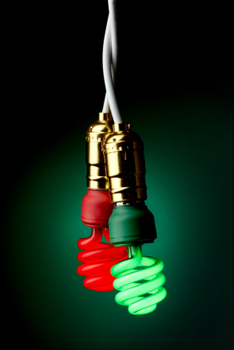Don’t wait for our lawmakers to see the light.
New efficiency standards for light bulbs were supposed to start phasing in January 2012, BUT on Friday, December 16, a Federal omnibus bill was passed that prohibits the Department of Energy from spending any money to enforce the efficiency standards.
Energy from spending any money to enforce the efficiency standards.
Signed into law by President Bush as a part of the Energy Independence and Security Act of 2007, the standards require about 25 percent greater efficiency (that is, less energy use) for newly manufactured household light bulbs that have traditionally used between 40 and 100 watts of electricity.
According to the National Resource Defense Council, when fully implemented, the lighting efficiency standards were predicted to save the average American household $85 each year, more than $12.5 billion nationally each year, and eliminate the need for more than 30 new large power plants.
When you choose CFLs for your home, look for those that have earned the ENERGY STAR label. These products meet strict energy efficiency guidelines set by the US Environmental Protection Agency. ENERGY STAR lighting products deliver exceptional features, while using less energy.
An ENERGY STAR labeled CFL:
- Saves money about $6 a year in electricity costs and can save more than $40 over its lifetime
- Meets strict performance requirements that are tested and certified by a third party
- Uses about 75% less energy than a traditional incandescent bulb and lasts at least 6 times longer
- Produces about 75% less heat, so it’s safer to operate and can cut energy costs associated with home cooling
- Learn more about the difference of ENERGY STAR qualified light bulbs
But what about the mercury contained in a household CFL? First, it is a very small amount — 4 milligrams as compared to 500 milligrams in an older thermometer. Second, the energy savings from using CFLs means that overall, less mercury is released into the environment through the burning of fossil fuels like coal. See Popular Mechanics, Compact Fluorescent Bulbs and Mercury: Reality Check for how much mercury power plants emit to light a CFL.
For you smart phone users, check out a new app called “Light Bulb Finder,” winner of EPA’s recent “Apps for the Environment” contest. This app is a step by step tool to finding the right CFL replacement bulb for every incandescent in your home. Takes the guesswork out so you spend less time contemplating in the store.
Another good source, DTE Energy’s instant rebate program for ENERGY STAR CFLs. Get $1.50 off the purchase price instantly of a qualified CFL at participating retailers.
There are plenty of recommendations for cleaning up and disposing of broken CFLs as well as for recycling those that no longer work. Even though the mercury content is small, taking precautions will minimize exposure.
Saving energy helps you save money on utility bills and protect the environment by reducing greenhouse gas emissions in the fight against climate change. Let’s not wait for our lawmakers to see the light. As consumers, we can embrace the new efficiency standards ourselves and take this opportunity to do something good for the planet.
Sources: Environmental Protection Agency, ENERGY STAR, Natural Resource Defense Council, Compact Fluorescent Lights: The Mercury Matter



